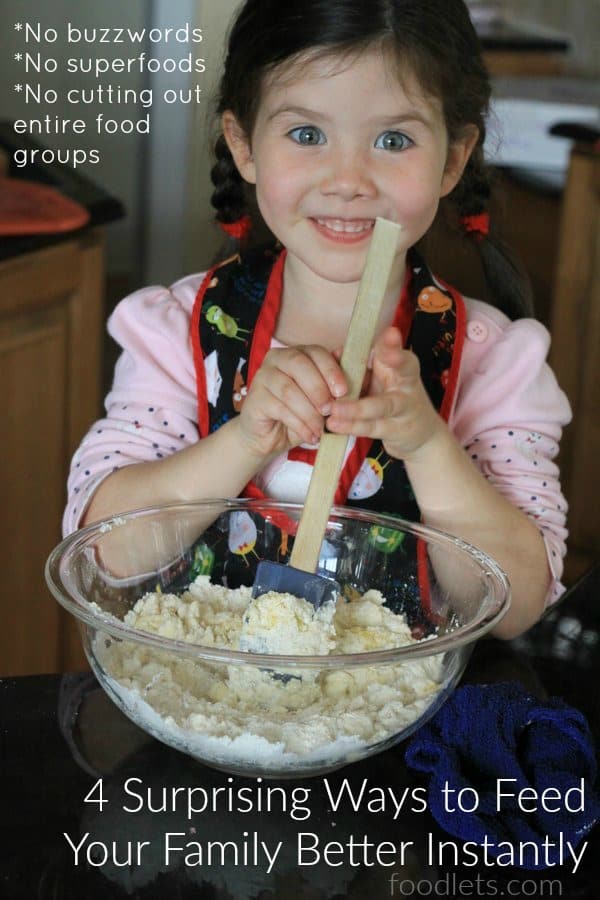Hey, are your kids good at trying new foods?
Let’s say you finally make that slow cooker recipe from the video you saw on Facebook. If your kids are like mine, a typical response might be any one of these:
- Thumbs up!
- One begrudging bite
- Small bodies slithering down their chairs like they’ve suddenly lost every last one of their bones #immelting
On behalf of all the moms who are like, Come on, people. Bones, please. I was so excited to read The 52 New Foods Challenge this week!
The idea is simple: Introduce a new food every week for a year, taking small steps toward raising kids who eat a greater variety of foods, which has been linked to making you healthier.
It’s also more fun to eat meals with people who are receptive to the idea of new–possibly delicious–foods. (When in doubt, I like to throw this one out: What if you’d never tried ice cream? Chocolate ice cream? But PSA, it doesn’t work in the heat of the moment. You have to bring it up at a separate time, either before or after a meal.) In fact that skill, having the curiosity and confidence to try new foods in any setting, is one that kids will be able to use for the rest of their lives. #thankyoumom
In the book you get 150 recipes, plus plenty of advice about how to pull it off by the author who has two kids of her own. Here are my favorite pieces of advice from the book:
Here are my favorite pieces of advice from the book:
Stop harping and have fun
Instead of feeling frustrated, asking yourself hypothetical questions like, “What child doesn’t like bananas?” Pivot. Make it fun.
My husband, Anthony, was getting the kids washed, brushed, dressed and ready for school. On the days when I was in charge of getting everyone out the door, there was usually rushing and barking involved (and I’m not talking about our family dog). But Anthony has a magical way of making just about anything fun. That morning, after they worked on a Lego project in the living room, he started to get the kids ready for school. “Race ya!” he yelled as he charged up the stairs to brush his teeth. “Let’s see if we can beat our record getting to school this morning!” he challenged. Giggling and skipping, my kids happily got themselves organized and were out the door, backpacks and lunches in tow, without any screaming or cajoling required. I watched the whole thing unfold as if I were watching a movie–with awe and disbelief. As the car door slammed and they cruised down the street, an idea popped into my head: “Why don’t we make healthy eating a game?”
Count your colors, earn points
Jennifer made up a dinner game (that later became Crunch a Color) based on earning points by eating different colors. The more challenging the food, the more points you got for trying them.
Kale becomes cool when it’s worth 15 points, and the race for bonus points suddenly had my kids begging for new foods to try. Beans, broccoli and even Brussels sprouts started showing up regularly at our family dinners. Not every food was met with a joyously warm welcome, but we were heading down the right path. With care and time, our simple mealtime game grew organically around our family table, rooting its way into the fabric of our meals until counting colors became second nature.”
Focus on new, not “healthy”
Just vowing to “eat healthier” can be overwhelming. Focusing on a challenge to eat one new food every week creates guardrails.
Take it 1 season at a time
It can still feel like an avalanche of responsibility to take on 52 NEW foods if you do it all at once. Jennifer broke it down into seasons. Zero in on a dozen ingredients at a time, and if you get off track one week you can easily jump back in. The winter foods include:
- Radicchio
- Avocados
- Asian Pears
- Black Beans
Prep for the week ahead
Spend an hour on the weekend to prep your new foods. Wash and slice the kale, cook the rice and so on. Prepping ahead of time will make new recipes seem more doable during busy weeknights. And bonus: these are easy tasks for kids to help with AND this exposure primes them for trying these foods later on.
Pair new foods with beloved foods
I’ve always called them bridge foods and Jennifer refers to beloved foods as “gateway foods”. The idea is the same. If your kids like blueberries (gateway food), try serving mangos (new food) mixed with blueberries. Or just put mangos next to the blueberries.
Taste the gateway food, then encourage a small taster of something new that complements. This can be as simple as putting a small amount of food on the tip of their tongue and letting them spit it out (they don’t need to swallow the food for this to work). Move toward mixing, but don’t be overly concerned if they want to keep foods separate. That is a natural tendency at a young age and one that most kids outgrow with time.”
Cook together, let them fumble and watch them grow
It takes longer and makes more of a mess but kids have to learn this basic life skill to flourish as adults. Not every meal, but make it a point to let go of speed and efficiency at least once a week. There’s nothing more powerful than learning themselves.
It’s one thing for me to tell my five-year-old that cracking the egg too hard on the edge of the bowl will result in a big sloppy mess on the counter, and an entirely different experience for him to learn that lesson firsthand, without Mom buzzing overhead like a helicopter. Leaving him to his own devices, he discovered that one of the easiest ways to remove bits of shell from cracked eggs was to use the half-shell he had in his hand.”
At the budding young ages of seven and ten, James and Catherine have mastered some essential cooking skills.
Even more than these discrete skills, my kids developed confidence in the kitchen, tapped into their creativity, grew a love of trying new things and learned to appreciate wholesome, healthy foods.”
Keep trying
Like every single thing about parenting, teaching kids to be flexible enough to try new foods takes time. Tons of it. Give your kids time to adjust. Don’t sneak the new ingredients in, but be really transparent about it. Show your kids the new ingredients but just introduce them slowly.
For example if you’re switching to whole wheat flour, Jennifer suggests not going cold turkey. Mix whole wheat flour into your supply of white flour, using a 1 to 4 ratio to start. Keep increasing the amount of whole wheat a little at a time until your switch is complete.
There is so much more advice, plus 150 simple recipes that highlight 52 possibly new foods in the 52 New Foods Challenge. And you have a chance to win a copy for yourself!



Leave a Reply